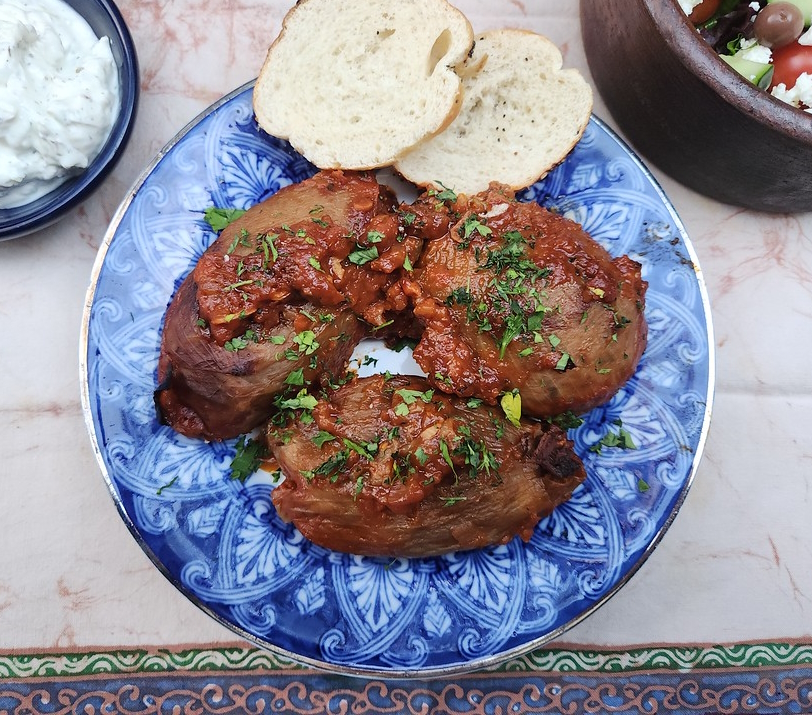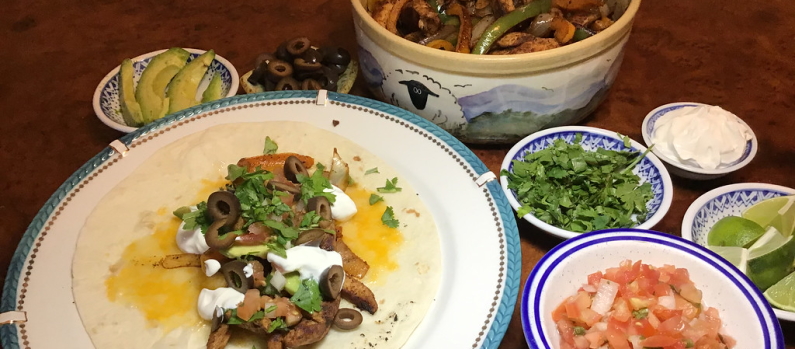
It would be difficult to find a dish that tastes so delicious and yet is so easy to prepare as Tex-mex Fajita! The dish is thought to originate from Tejano chefs whose families emigrated to the United States from the Northern states of Mexico. "Tejano" is Spanish for "Texas".
As mentioned in the summary above, Tex-Mex food is cuisine which has its origins in Texas by ranch workers who emigrated from northern Mexico. The name fajita is derived from the Spanish word faja which means strip, belt or girdle (referring to how the beef or chicken is cut). Fajitas are a rather new creation, dating to the 1930's or 40's. The first mention of Fajita is in print was in 1971 (Oxford English Dictionary). The original (and some believe the only authentic) fajitas are made with strips of seared beef (notably skirt steak, but nowadays chicken is popular too. Fajitas contain many ingredients that are indicative of Tex-Mex cooking: flour tortilla, cumin and often cheddar cheese. Fajitas differ from burritos mostly because of their fillings (although fajitas often use smaller tortilla and are assembled by the diner). Burritos often (there are lots of variations) contain ground beef and beans, while Fajitas used grilled strips of marinated meat, bell peppers, onions and cheese.
Much of what most Americans and in many parts of the non-Latino world consider to be Mexican food is actually Tex-Mex. RThe major difference between Tex-Mex and food found in Mexico is mostly determined by ingredients used because ranch workers used what ingredients were available to them, but some dishes are rather unique to Tex-Mex. The term "Tex-Mex" first came into use in the 1940's. Ingredients much more likely to be found in Tex-Mex than Mexican food include: ground beef, yellow cheese (like cheddar), wheat flour, black beans, canned tomatoes and cumin. But one must always be careful when employing broad generalities to describe Mexican food because Mexico is a big country and there are many regional culinary variations. The spice cumin, often found in Tex-Mex food, originates in South Asia and was adopted in the US much earlier than in Mexico. Many, if not most, Tex-Mex dishes use cumin liberally. So too, outside of tortas, it is much more likely that Tex-Mex dishes use wheat flour tortillas rather than corn. Some popular Tex-Mex dishes (which are commonly served in Mexican restaurants here) include: Nachos, Chile Con Carne (ground beef, cumin and canned tomatoes), Fajitas, the ubiquitous Burrito and its deep fried cousin Chimichanga.
Interestingly enough, hard-shelled tacos—considered by many as the epitome of Americanized Mexican food—are not, in fact, Tex-Mex. Hard-shelled tacos have a long but uncertain history, there are competing claims to their origin, some dating back to the 19th century. However, in 1947, Juvencio Maldonado, a New York restaurant owner from Oaxaca obtained the patent on the shell-making device. The original drawing for the patent can be seen here. But hard-shelled tacos didn't really catch fire until Glen Bell in San Bernadino, California opened Taco Tia in the mid-1950's. Shortly thereafter he re-branded as Taco Bell. For many Americans who live in states with few Latino residents, Taco Bell might be the closest they get to Mexican food. Bell didn't invent the hard shell taco—he reversed engineered the tacos he ate at nearby Mitla Cafe—but there is no doubt he popularized them. There are now more than 6,000 Taco Bell's in 26 different countries. Perhaps not surprisingly, Mexico is not one of those countries, as repeated attempts to open Taco Bells in Mexico have failed spectacularly.
While historically fajitas are made with beef, we have a slight preference for chicken. Some make them with shrimp. Otherwise, the marinade and recipe is the same. It's your choice. Fajitas taste best if you grill the meats, onions and bell peppers, but you can approximate this with a cast iron skillet. We actually used a Korean barbecue grill as the juices can run off and you can get a good sear! We make our own simple salsa with canned tomatoes, canned jalapenos, onions and lots of garlic. Some might prefer fresh ingredients to canned, but the taste and texture will be different. Normally we prefer fresh ingredients for just about everything we cook—this is an exception. There are some good commercials salsas, but most are not to our liking. Also we like to top the tortillas will cheese and heat them so the cheese melts, definitely not "traditional" but mighty tasty! This is a dish that permits lots of leeway; it's hard to get it wrong.
Ingredients:
Primary:
- 2 pounds chicken breasts fillets sliced into thin strips
- 1 red bell pepper sliced into thin strips
- 1 green bell pepper sliced into thin strips
- 1 medium onion sliced into thin strips
- A sufficient number of flour tortillas
Marinade:
- 2 Tablespoons Extra-virgin Olive Oil
- 2 Teaspoons ground cumin
- 1 Tablespoon smoked paprika
- 1 Teaspoon crushed garlic (more if you like!)
- 1 Tablespoon lemon or lime juice (we prefer the latter)
- 1 Teaspoon salt
- Chili pepper (to taste)
Toppings:
- Salsa of your choice
- Sliced avocado or guacamole
- Sour cream or crema
- Sliced black olives
- Chopped cilantro (essential!)
- Shredded lettuce
- Lime(s) cut into 1/8ths
- Cheese of your choice (medium Cheddar, Colby, Jack, Manchego, Queso Asadero . . .)
Preparation:
The most common way to eat fajitas is to serve the cooked ingredients in a dish placed on the table. The other ingredients can be placed in small individual serving dishes. Each family member or guest can assemble their own fajita using the toppings of their choice.
- Mix the chicken with the marinade ingredients, cover and chill in the refrigerator for 1 - 4 hours.
- When the marinade is finished in the fridge, slice the peppers and onions.
- Grill or fry the chicken and vegetables until done. If using a fry pan, fry the chicken first, then set aside and then fry the peppers and onions. Ideally the peppers should be slightly scorched.
- Mix the chicken, peppers and onions together and set aside.
- Clean the fry pan and then place it on a medium high heat (no oil necessary).
- Place a tortilla in the pan, top with a handful of cheese and wait until the cheese melts before moving to a plate for serving. (Note, a trick I use is to preheat the cheese-topped tortilla in the microwave until the cheese starts to melt and then finish by transferring to the hot skillet. This fully melts the cheese without the tortilla becoming soggy (which happens if you only use the microwave) or too crispy on the bottom if you use the skillet alone.
- Festoon with the toppings of your choice, roll and enjoy!
Recipe by T. Johnston-O'Neill
Photo by Shari K. Johnston-O'Neill
- Details
- Hits: 3613
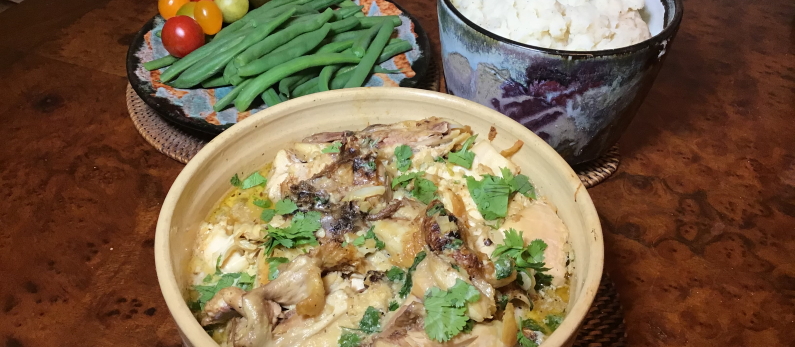
With only a handful of major ingredients, preparing Georgian Shkmerul could not be easier to pull off. It's been a very long time since we have been so delightfully surprised by a dish—it's delicious!
>Originating from the Racha region in the Republic of Georgia, Shkmeruli is a popular dish that has only a few ingredients (most, if not all, you might even have on hand). The dish is named after the mountain village of Shkmeruli, but it is popular throughout the country. Racha is known for its strong cultural traditions (several marked with holidays), beautiful architecture (including colorfully decorated homes), cuisine, long wine-making traditions and natural beauty including waterfalls, alpine lake, lush meadows and glaciers.
As a cultural aside, in the last year or so Shkmeruli has become a craze in Japan! First introduced by the major Japanese restaurant chain Matsuya, "Shkmeruli Nabe-don" has become a Japanese phenomena with Yahoo News Japan recently declaring "This winter the most popular dish in Japan is Shkmeruli." The dish was introduced in honor of the now postponed 2020 Olympics, but it caught on like wildfire. It's not quite the cultural stretch it might at first seem. In Japan the terms nabe or nabe-mono refer to dishes we might call "hot-pots"; the most famous here is Shabu-shabu which is a form of Chinese hot-pot introduced to Japan in the 1960's. But there are several other nabemono dishes that are popular in Japan. When it was introduced by the Matsuya, they advertised it with a sign-board that read "Matsuya Sekai (World) Journey Georgia".
The most basic Shkmeruli consists of a cut-up roasted whole chicken, milk and garlic. In Georgia it is often served in a clay baking bowl called a ketsi. Typically Shkmeruli is served with a variety of side-dishes which almost always includes tomatoes and fresh cilantro. Some cooks also suggest spooning it over cheesy or regular mashed potatoes (which is what we did—it was awesome). A crusty bread is also a fine complement. When cooking the chicken, whichever method you choose, it is important to brown it as this brings out the flavors that with the garlic will permeate the sauce. Milk is well-recognized as a useful ingredient for marinades for its ability to both soften the meat and lock in flavor. Matsuya's version also has cheese (not sure what kind) melted on the top of the dish. This recipe works best with whole milk.
e>Cook's note: The part of this recipe that might be unusual is that it usually calls for spatchcocking (sometimes known as butterflying) the chicken before frying. Cooking a chicken this way retains its juices and you might be surprised by how tender the white meat is. It is claimed that if you roast a chicken this way it will cook in about half the time. Here is a tutorial for that process: How to Spatchcock a Chicken from The Spruce Eats. It is not difficult at all. If you cook a chicken in this method, it's a good idea to put something heavy on the topside of the chicken so that it browns evenly. A pot filled with very hot water might do the trick (as you don't want to cool the chicken down). However, it is not absolutely necessary to cook the chicken spatchcocked. You can instead use a cut-up whole chicken or cut the chicken up yourself. If you are unsure of how to cut up a chicken, Martha Stewart has a slideshow: How to Cut Up a Whole Chicken. Also, for this recipe, you must first brown the chicken in a skillet and then roast it. Whichever method you choose, after it is fried it needs to be cut into even smaller pieces before simmering in the milk.
Ingredients:
- 1 whole chicken
- 1 cup whole milk
- 8 to 10 garlic cloves (a little less than an ounce)
- 2 tablespoons of butter
- Neutral-tasting vegetable oil (don't use extra-virgin olive oil)
- Salt and pepper to taste
- Chopped fresh cilantro
Preparation:
- Preheat an oven to 400°F.
- Spatchcock or cut up the chicken.
- In a skillet on medium to medium-high heat, brown the chicken or chicken pieces on both sides. Note: You are just browning the chicken, not fully cooking it at this stage.
- Do not clean the skillet yet—you will need the leftover oil and bits of chicken left in the pan.
- Using whatever oven-proof pan you have, roast the chicken uncovered for another 30 minutes.
- Remove the chicken from the oven and let it rest. Do not turn off the oven—you will use it again in a few minutes.
- Peel and crush the garlic into a paste (don't slice or dice it). You can use a mortar & pestle or simply smash the garlic repeatedly with the side of a big knife or smash it with a kitchen mallet.
- Warm the skillet up to medium high, add the butter and sauté the garlic in the residual juices/oil remaining in the pan. Note: it is almost always better to add ingredients to a hot, rather than cold skillet.
- Add the milk to the skillet and scrape the sides and bottom of the pan. These bits are known as the fond in French cooking and they are rich in flavor.
- Stir, scrape and boil for about 2 minutes.
- Cut the now cooler chicken into medium sized pieces (see photo above).
- Move the chicken to an oven-proof dish/bowl bake, add the milk/garlic sauce and heat in a 400°F oven for 5 minutes.
- Garnish the Shkmeruli with chopped cilantro.
Gemrielad Miirtvit! (Bon Appetit)
Recipe by T. Johnston-O'Neill
Photos by T. & S. Johnston-O'Neill
- Details
- Hits: 3607
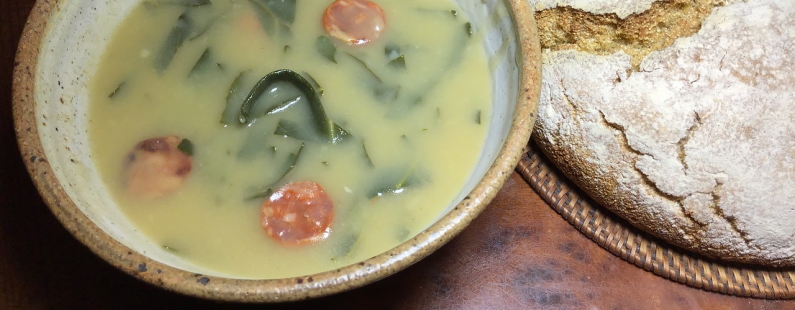
Portuguese Caldo Verdes easy to prepare soup is considered to be Portugal's national dish. It has many variations but, understandably all look like "green soup"!
Enabled by their large fleet of sailing ships Portugal beginning with the capture of the small territory of Ceuta in Northwest Africa and finally coming to an end in 1999 when they turned over Macau to China, Portugal created one of the largest and longest surviving empires the world has ever seen. The time when Portugal began colonizing territories throughout the world is often charitably called the "Age of Discovery," but it was more accurately the "Age of Conquest". Even today Portugal is one of the least diverse places in the world (which contrasts greatly with several of its former colonies). However Portuguese cuisine has been greatly shaped by cross-cultural currents both from former colonies and from France, Spain and Northern Africa. Not only that, but dishes that originated in Portugal can now be found throughout former colonies.
One of these is Caldo Verde (trans: "green broth"). It appeared first in the region of Minho in northern Portugal sometime in the middle of the 15th century. In Portugal the soup is popularly served at weddings, birthdays, assorted holidays such as New Years and events such as the St. John's Festivals in the cities of Braga and Porto. However, Caldo Verde can be and is eaten on any day; it's a staple dish. In Portugal it is often eaten with a corn/rye bread called Broa de Milho. The dish is mentioned in many books by Camilo Castelo Branco, Portugal's most prolific novelist. In Brazil is often served during the winter festival, Festa Junina (June Festival).
Meat, poultry and especially fish are common ingredients in Portuguese dishes. Ideally (or perhaps, most commonly) chouriço (in Spain chorizo) or milder linguiça (smoked Portuguese sausage) is added to Caldo Verde. Chouriço is a fermented, cured, smoked sausage that is either eaten cooked or "raw" (but, again, it is fermented and smoked). Mexican Chorizo is entirely different and not used in this dish. Portuguese chouriço and Spanish chorizo are dark red in color due to the addition of copious amounts of dried and smoked red peppers (pimentón/pimentão). However, salt pork, other types of smoked sausage or bacon can be substituted. Or you can completely eliminate any meat, substitute vegetable stock and have a delicious vegetarian soup. Another common variation is in the selection of the leafy vegetable to flavor the soup and color it green. More traditionally Portuguese collard greens (couve galega) are used, but many recipes use kale (closely related to collards) or mustard greens. Collard greens have a very long history (they were consumed in Greece 2,000 years ago) and are eaten in many countries and regions throughout the world, from Brazil and the United States to Kashmir, parts of Africa and many places in Europe. In Brazil, Portugal and in the Southern United States collards are also grown as garden ornamentals! There are many regional variations of caldo verde and, as is always the case, considerable variation from cook to cook. Some recipes add white beans for an even heartier soup. Often the potatoes are pureed before the addition of the collards, and often chicken stock is used instead of water. Some recipes don't puree the cooked potatoes, adding heavy cream as a thickener. In Portugal the chouriço is added to the dish right before serving, but in Brazil it is cooked with the soup. Another difference is that in Portugal Caldo Verde is typically eaten with Broa de Milho, but in Brazil toast or French rolls are more common.
Caldo Verde Ingredients:
- 6 cups of water (or chicken stock)
- 3 pounds of potatoes, peeled and diced. Note, if you puree the potatoes, use russets. If you want to have chunks of potato, use yukon gold or white potatoes.
- 1 large onion, chopped
- 2 cloves garlic, chopped finely or crushed
- 1/2 cup of Portuguese olive oil (or extra virgin olive oil)
- 1 pound of collard greens or kale, stems removed and thinly sliced
- 10 ounces of 1/4 inch wide sliced Chouriço, Spanish Chorizo or other smoked sausage
- Salt and Pepper to taste
Caldo Verde Preparation:
- Bring the water or chicken stock to a boil.
- Add to the water the potatoes, onions, and garlic.
- Boil for 20 minutes (note: if you want chunks of potatoes, see note above about potato choices and only boil for 10 minutes).
- Reserving the liquid, strain, let cool and then puree the potatoes in a blender, hand mixer or food processor.
- Lightly fry the smoked sausage and set aside.
- Return the broth and pureed potatoes to the pot and bring to a boil.
- Add the collards and the olive oil to the pot and boil for an additional 6 minutes.)
- Add the sausage to the pot cook for an additional minute. (Note: Some cooks add the sausage slices to the individual servings)
- Serve with salt and pepper on the side and Broa de Milho.
Broa de Milho Ingredients:
- 4 1/3 cups of cornmeal
- 2 cups rye flour
- 1 cup all purpose flour
- 1 3/4 cups boiling water
- 3/4 cup plus 2 tablespoons of hot water(95°F)
- 1 package of baker's yeast
- 4 teaspoons of salt
Cook's Note: There are two kinds of yeast that are most commonly used for baking: "Active Dry Yeast" and "Fast Rising, or Fast Acting". Either can be used. However, Active Dry Yeast, being slower should be "proofed" before using. This is done by mixing the yeast with 2 tablespoons of hot water (105 - 115°F) and 1/8th teaspoon of sugar, letting the mixture to ferment for 5 to 10 minutes before using. This recipe calls for 3/4 cup of hot water plus 2 tablespoons of hot water, making it easy.
Broa de Milho Preparation:
- In a mixing bowl, mix the cornmeal with the boiling water and let sit for 1 hour.
- Thoroughly mix the hot water and remaining ingredients into the hydrated corn meal.
- Knead into a ball, return the dough to the mixing bowl, cover and let rise for 7 or more hours at room temperature.
- Form the dough into a loaf and generously powder the top with all purpose flour.
- Bake at 400°F for 1 hour on a pizza stone (best), cast iron pan or baking sheet. If you use the pizza stone or cast iron pan, place it in the oven when pre-heating and keep at 400°F before placing the dough on it.
- Cool before slicing.
Bom apetite!
Recipe and cultural introduction by Priscila Damasceno & T. Johnston-O'Neill
Photos by Shari K. Johnston-O'Neill
- Details
- Hits: 2974
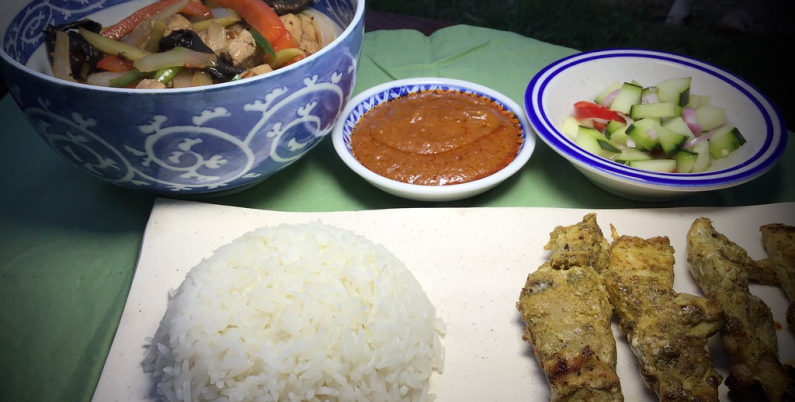
We have a double billing for the Participant Observer Recipe of the month: Gai Pad Khing (Thai Ginger Chicken) and Moo (pork) Satay (with Ajaar pickle salad). The satay makes a great appetizer (and oddly enough it's the more complicated recipe while the Thai Ginger is a delightful spicy dish that gets it's heat from copious quantities of ginger! >As we have noted in so many previous recipes, so much of the world's cuisine and every country's signatures dishes are the result of cross-cultural flows of ideas, ingredients and historical contact. Plantains originally come from India, chilies enjoyed around the world originated in Meso America, Japanese tempura may have been learned from Portuguese missionaries, Vietnamese Pho was influenced by French cuisine, and even Fish and Chips owe much to Sephardic Jews who emigrated to England. Thailand has not been immune to such historical-cultural processes, but because it was never missionized to any great degree, because it was never colonized by nations afar, and because it has relatively less immigration, its cuisine has been more culturally unique than the food found in other nations and most of the cross-cultural influences are a bit closer (Laos, Burma/Myanmar, Cambodia, and originally China). Of course, some Thai ingredients do have origins from afar (notably chilies brought by the Portuguese in the 1600's), but again it's a difference of degree not of kind. Oddly enough (as mentioned below), eating utensils do owe their prevalence to European influences. Chickens originated in Southeast Asia and pigs have been raised for meat for a very long time in Asia, as they were first domesticated in Mesopotamia as early as 13,000 BC!
The satay recipe uses pork, the overwhelming choice in Thailand. But elsewhere in Southeast Asia, beef, water buffalo and chicken are used for satay. You can use any of those meats in this recipe if you have a preference other than pork. If you have never had Thai Ginger Chicken, you might be misled by the recipe to think that it goes overboard with ginger. Indeed this amount of ginger leads to a spicy-hot experience that doesn't rely on any chilies. But cooking the ginger brings down the "temperature" quite a bit (the longer you cook it, the milder) but the "bite" makes this dish rather uniquely delicious. Some recipes call for the addition of red chilies, but this is somewhat unnecessary as unless you overcook the ginger substantially, it will have more than enough "heat" to enjoy. You can easily adjust the spiciness of the dish by using more or less fresh ginger. We prefer dark meat chicken for this dish (it remains juicier and has more depth of taste), but feel free to substitute breast meat if you so desire. Perhaps the ingredient that is most unusual is the Tao Jiew, fermented soy bean paste, but we give you several reasonable alternatives. Dried wood-ear mushrooms also might not be a readily available, but fresh can be substituted and other mushrooms can be used as well. The scallions are added last, mostly to add a splash of green color. Like many Southeast Asian foods, these dishes combine salty, sweet, sour and spicy, a combination that creates a lovely riot of tastes in your mouth. It's interesting that in America when we meet someone we typically say "How are you?", where my wife and I lived in Indonesia, the favored greeting is "Where are you going? (Mau kemana?)", in Thailand when people meet they often say "Gin khao yung?” or "Have you eaten yet?" Unlike most places in Asia, chopsticks aren't very popular in Thailand; since the reign of King Rama IV in the 19th century, spoons and folks have been the standard. Large spoons held in the right hand, perhaps aided by a fork (to push food onto the spoon) in the left are preferred for eating rice-based dishes. Chopsticks are mostly used for standalone noodle dishes.
Gai Pad Khing (Thai Ginger Chicken)
Ingredients
- 1 pound of boneless chicken (dark preferred) cut into bite-sized pieces
- 1 ounce dried wood-ear mushrooms, re-hydrated (also called "cloud-ear mushroom" or "black fungus")
- 1 ounce finely julienned ginger (about 1/4 cup, peel first)
- 2 teaspoons of minced garlic (about 4 medium sized cloves)
- 1 tablespoon Tao Jiew Thai fermented soy bean paste (can substitute with Indonesian/Malay Taucho, Japanese aka (red) miso or Korean doenjang)
- 1 tablespoon oyster sauce
- 1 tablespoon fish sauce
- 1 teaspoon of sugar
- 1 red bell pepper, sliced
- 1 medium onion, sliced
- 2 scallions (green onion), sliced
- Dash of white pepper
Preparation:
- Soak dried mushrooms in hot water for 20 minutes.
- Cut chicken into bite-sized chunks.
- Slice red pepper and onions lengthwise and set aside.
- Peel and julienne the ginger and set aside.
- Slice the scallions along the bias to make 2" pieces.
- Drain and squeeze the water out of the mushrooms and set aside (discard the water).
- Mix together the soybean paste, oyster sauce, and sugar.
- In a wok or fry pan on medium high, sauté chicken pieces, stirring constantly, until 60 percent cooked.
- Add to the partially cooked chicken the garlic, bell pepper, mushrooms, onions and ginger.
- Continue frying until the chicken is completely cooked.
- Add the sauce and white pepper and stir constantly for 30 more seconds.
Moo (Pork) Satay
Ingredients
- small 6-inch bamboo skewers (soak in water for 1 or more hours before starting)
- 1 pound of pork loin chops
Marinade
- 1 1/2 teaspoon whole coriander seeds
- 1/2 teaspoon whole cumin seeds
- 1/2 teaspoon white pepper
- 1 teaspoon turmeric powder (can use fresh ground too!)
- 1/8 teaspoon ground cinnamon
- 1/8 teaspoon ground cloves
- 2 teaspoons brown or white sugar or palm sugar
- 1/2 teaspoon salt
- 1 tablespoon finely chopped lemongrass (may substitute dried lemongrass or lime zest)
- 1 teaspoon galangal root finely chopped (optional) may substitute 1/2 teaspoon dried powder
- 1/teaspoon white vinegar
- 1/3 cup coconut milk (shake container vigorously before opening because the fat separates)
- 1/4 cup water
Preparation
- In a toaster oven at 350° or in a medium hot fry pan, toast coriander and cumin seeds until they are light brown and fragrant (be careful not to burn the cumin seeds).
- Grind the cumin and coriander seeds to a fine powder in a mortar and pestle or a spice mill.
- Combine all the remaining ingredients in a bowl and mix well.
- Cut each loin chop in half parallel with the fat cap, then slice perpendicularly in 1 inch pieces.
- Place the pork in a bowl and cover with the marinade.
- Using your hands (you may use gloves as the turmeric will stain your hands) thoroughly mix the pork with the marinade so that all sides are completely covered.*
- Cover the bowl and let marinate in your refrigerator for 4 or more hours (preferably overnight).
- Impale the pork pieces on the pre-soaked bamboo skewers leaving enough space and the blunt end to grip and covering the tip of the skewer.
- Pre-heat your barbecue to medium high heat.
- If the marinade is not fully covering the satay, brush with coconut milk before grilling
- Grill the satay on both sides, so that it has a slight char but not overcooked. (note if you fold some aluminum foil and place it under the exposed bamboo to keep it from burning).
* Note: the only thing I have found that removes turmeric stains is direct sunlight. It works like magic!
Thai Peanut Sauce
Ingredients
- 1/2 cup roasted peanuts, or 1 package of "bumbu sate" (available at 99 Ranch market in the Indonesian section). Note: If using the bumbu sate, omit the palm sugar below.
- 1 tablespoon red curry paste
- 1 cup coconut milk (shake container vigorously before opening)
- 2 teaspoons Thai or Vietnamese fish sauce
- 2 tablespoons shaved, chopped or chopped palm sugar
- 2-3 tablespoons tamarind juice (may substitute 1 1/2 tablespoon fresh lime juice)
Preparation
- On medium heat boil 1/4 cup of the coconut milk in a saucepan
- Continue cooking the coconut milk until it becomes thick to the point that the oil begins to separate.
- Mix in the red curry paste and cook an additional minute or so.
- Add the additional ingredients and continue cooking until the oil (which will be a lovely red) begins to separate.
- After the oil begins to separate the sauce will be very thick. You can thin out and smooth out the sauce by adding a tablespoon of water at a time until it's the desirable constancy.
Serve with jasmine rice, or as is now common with Thai street satay, thick slices of grilled white bread good for dippin' in the sauce.Ajaar Cucumber Pickles
Ingredients
- 1 large cucumber, seeded and diced or sliced thin
- 1-4 hot Thai chilies, sliced very thin (okay to substitute with milder peppers)
- 1/4 of a medium onion, or 4-5 scallions, sliced very thin
- 1 cup rice or white vinegar
- 1/2 cup white sugar
- 2 teaspoon salt
Preparation
- Heat vinegar, sugar and salt in a saucepan and stir until sugar and salt are completely dissolved.
- Let liquid cool to room temperature or cool in refrigerator.
- Mix the sliced cucumbers, peppers and onions/scallions in a medium-sized bowl.
- Pour the cooled sweetened vinegar over the vegetables.
- Best if "pickled" for a few hours, but can also be consumed immediately.
Special Note: Each of these recipes are substantially based on recipes created by Pailin Chongchitnant for her Hot Thai Kitchen website and Youtube channel. Her videos, culinary knowledge, and preparation guidance are simply the best. Pailin also has a cookbook of the same title which can be found here.
Additional notes: Long long ago (2008?) we published a recipe for Gai Pad Khing, but this recipe is, we believe to be a better version.
Recipe by T. Johnston-O'Neill
Photos by Shari K. Johnston-O'Neill
- Details
- Hits: 3132

Homemade Bagels with Nova lox are a true delight. A quintessentially Jewish-American creation, if you follow this recipe you can greatly improve on most store or shop bought bagels. When you are up for a superior breakfast or brunch I can think of nothing else that is more glorious.
In "The Yada Yada" Seinfeld episode Jerry is disturbed when his dentist converts to Judaism and becomes a stand-up comedian. What gets Jerry's goat is that he believes that his dentist's conversion is only because he wants to tell "Jewish Jokes". I grew up in an area of Philadelphia that had a large Jewish population which for me was in all ways wonderful. In high school I got to try a variety of Jewish food both in people's homes and in restaurants. Nearly every time I visited my friend Richard, I pestered him for a toasted bagel with butter. I have often joked that I might convert to Judaism, "just for the food". Tops on my list of Jewish culinary delights is real Jewish rye bread, and, of course, what I consider to be the "King of All Breakfasts"—Bagels and Lox. What I didn't realize when growing up is that this noble concoction is a relatively recent invention, the combination arising in Philadelphia and New York in the late 1940's. Bagels were brought to America by Jewish immigrants in the early 20th century; but their pairing with smoked salmon is far more recent. The first mention in print of "Bagels and Lox" was in 1954 advertisement by Kraft Foods, which makes Philadelphia brand cream cheese. It's a uniquely Jewish-American creation.
Lox originated in Scandinavia (particularly Sweden) and is smoked salmon. For many, including myself, the highest expression of this delicacy is "Nova". Regular lox predates nova and is cured in salt. Lox is not smoked and is very salty. Nova, which denotes it comes from Nova Scotia and is short for Gaspé Nova. Gaspé is a city in that Canadian province. Gaspé Nova is first cured in salt and sugar and then is "cold smoked". So if you find yourself in a good Jewish deli and you order "lox", more than likely you will be served "nova". If you really want cured un-smoked salmon, you need to ask for "belly lox". There are many other types of cured and smoked salmon available, but these two are most often associated with bagels.
The other components of the ultimate lox and bagel experience are cream cheese, capers, red onions and slices of juicy tomato. If you say "cream cheese" most people immediately think of Philadelphia because Philadelphia Cream Cheese is the the leading brand of cream cheese since 1800. However, the cheese was made in upper state New York and has never been manufactured in Philadelphia. The name was chosen because the Philadelphia area was known for quality dairy products. So the name is pure marketing. Many bagel shops now offer a "bagel with schmear" denoting a bagel with lox-infused (or some other flavoring) cream cheese. But originally a "full schmear" that is simply a bagel with spread cream cheese.<
Unfortunately it is rather difficult to find traditional Jewish rye bread or great bagels anymore. Great Jewish rye is dense and has a chewy texture. This is achieved by "steam proofing" by injecting steam into the proofing oven while the dough is rising and also injecting steam into oven when the bread is baked. In the last couple of decades, most Jewish rye doesn't undergo this treatment, and as a result they are, in my opinion, "cakey" in texture. The preferred technique for bagels is "kettling", the raw dough is formed into a bagel and then dropped into a large pot of boiling water. George Greenstein who wrote the wonderful book Secrets of a Jewish Baker recommends placing a cooking tray at the bottom of the oven and then tossing 6 to 8 ice cubes onto the tray right after you put the bread or bagels in to bake. I have yet to encounter a truly great bagel in San Diego, and some say that it's even difficult to find a great bagel in New York or Philadelphia nowadays. This pressing desire for bagel euphoria compelled me to learn how to make my own. The results (on the 2nd try) were outstanding!
In researching this recipe, I looked at a number of printed recipes, online recipes and more than a few YouTube videos. More so than other foods that I have worked in the many years writing recipes, the recipes for bagels have a huge variation in preparation instructions. Recipes range for proofing from 50 minutes to 2 hours, some call for "cold proofing" the dough for 24 hours, and some 48 hours. Some recommend kneading the dough for 5 minutes while other recipes say 12 minutes. Some call for lots of yeast, some call for a scant amount. Probably the greatest variations between recipes are baking temperatures; some suggest 200°F while most other 450 - 500°F! Some suggest rolling the dough into ropes that are formed into circles, some call for poking a whole in the center of a dough ball and then stretching the hole. Either bagels are the most forgiving of preparation techniques or people want vastly different results. I strove to create a bagel that was chewy, a bit on the dense side with a crunchy crust. My first attempt was not particularly successful. The bagels were not particularly chewy, and I think they were insufficiently crusty. They were under baked, just like the bagels one finds in most bagel shops where the crust is nearly white. I also used what too much salt sprinkled on top. I stared from scratch again, this time with longer kneading, and a longer boiling time. I achieved a much better result the 2nd time around!
Ingredients:
- 2 cups of warm water
- 1/2 package (1 1/2 teaspoon) active dry yeast
- 4 tablespoons (split) malt barley syrup (or 2 tablespoons sugar)
- 6 cups bread flour
- 1 tablespoon salt
- Olive oil
- 1 egg beaten
- Dried minced garlic, onion flakes, poppy seeds, sesame seeds and medium coarse kosher salt for toppings
- For serving: Cheese, capers, Nova lox, a quality red tomato, red onion sliced thin
Preparation:
- Heat 2 cups of water to 100 - 105°F. and pour into a bowl or measuring cup.
- Sprinkle yeast on water and mix in. Note, if you are concerned that your yeast is old, add the syrup or sugar at this point and wait a couple of minutes to see if bubbles form.
- Add the flour, salt, 2 tablespoons barley malt syrup* to a mixer bowl. If you are using a stand mixer, set on the lowest setting for about a minute, then slowly pour in the water with the yeast.
- Raise the mixer setting to the next highest speed and mix for 5 - 8 minutes. At intervals you might have to stop the mixer to push down the dough if it tries to escape.
- The dough should be a tiny bit sticky. If you take a small piece of it and stretch it out and it becomes very thin and translucent, you have got it right.
- Remove the dough from the mixer and knead it into a big ball.
- Oil a mixing bowl with just enough oil to coat the entire bowl, not so much that it pools up in the bottom of the bowl.
- Place the dough in the mixing bowl, cover with plastic wrap or a wet kitchen towel, and place the bowl in a warm place.
- Proof the dough for 1 hour; it should double in size.
- Place a rack in the center of your oven, set the oven to 500° and push start.
- Remove the dough, use a pastry cutter (I used a thin cleaver) to cut the dough into 12 equal portions. I cut the ball of dough in quarters and then each quarter into three. If you use a kitchen scale (which I did), each portion should be about 4 ounces (1/4 pound).
- Individually, take each portion and with your fingers repeatedly pull the sides up and over the center of the ball, rotating as you go. This will leave a (mostly) smooth surface on the bottom.
- Flip the dough over on a work surface and cup your hands over the dough pushing down on the center with your palm and pulling the bottom in with your fingers, rotating to dough. Repeat for all 12 portions. See picture for what the dough balls should look like
- Fill a wide 6 quart pot 3/4 full and set to boil. When the water gets hot, add 2 tablespoons of the malt syrup.*
- Cover the dough with a damp cloth and let rest for 10 minutes.
- Take each ball of dough and pierce the center with your thumb and middle finger until you break through and your thumb and finger are touching. Then poke each of your index fingers into the hole (from opposite directions) and rotate your fingers to make the hole large. There will be a bit of contraction of the dough when you remove your fingers, so make a hole slightly larger than you want the hole to turn out.
- Cover a sided baking sheet with a sheet of parchment paper.
- Place each bagel on the sheet in a 3x4 grid pattern.
- Beat but don't whip an egg and a very small amount of water in a bowl.
- The water should be boiling by now; turn it down to a gentle bowl.
- Using a "spider" (a large round spoon filled with holes), place 4 bagels in the bowling water at a time. Do this "bottom side up".
- Boil the bagels for 1 1/2 minutes a side. If all goes well, this step will make the outside of your bagel more chewy and create "micro blisters" on the crust that with make them crunchier.
- Return the bagels "top side up" to the parchment-covered baking sheet.
- Brush a thin coat of the egg wash on each bagel.
- Sprinkle the toppings on each one the bagels. Add the toppings in whatever manner you like, but if you want to make "everything" bagels, don't mix all the toppings together before you sprinkle (as many recipes suggest) because all the smaller ingredients (like sesame or poppy seeds) will migrate to the bottom of the mixing bowl and you won't be able to distribute things as evenly. Instead sprinkle each ingredient separately.
- Bake the bagels at 500°F for 20 minutes or so. The onion and garlic will become very dark brown. If you don't use those ingredients, you can even bake long enough to get a good brown on the bagels. Every oven is different, so after 15 minutes, keep a close eye on the bagels. Most store-bought bagels are very under baked and even bagel shop bagels are frequently under baked and soft on the top.
- The book Secrets of a Jewish Baker, in which this recipe somewhat follows, suggests placing a sided baking sheet on the bottom of the oven and pouring several trays of ice cube on the hot tray right after the bagels are placed in the oven. This creates a low-pressure steam in the oven. I did this when making rye bread, but not with the bagels (I will try it next time!)
- After the bagels are fully cooled, they are ready to be sliced. There is a trick to slicing bagels evenly. Don't try to saw through the bagel from side to side. Instead slice only as far as to when the blade cuts through to the center hole and then rotate the bagel as you slice. There is an unsafe way (which I tend to use) and a safer way to do this. I hold the bagel in my left hand and slice with my right, rotating the bagel with the hand that is holding the bagel. Obviously I am breaking the cardinal rule of cutting anything (don't cut towards yourself), but thankfully there is another way that is safer. Hold the bagel vertically gripping the top with your left hand, insert the bread knife between your hand and the bagel cutting downward while rotating the bagel.
To serve:
I prefer toasted bagels—I even have a toaster that has a bagel setting which toasts one side more than the other (oddly it does so of the wrong side and I have to put the bagels in with the outsides toward the center). But a toaster oven provides much better control. If you do toast the bagel, you need to let it cool a bit, otherwise when you smear it will cream cheese the cheese will liquefy. I then sprinkle the cream cheese with capers—this keeps the capers from running loose all over the place. Then I add the Nova lox; only one layer is necessary. I follow this with a nice juicy slice of red tomato and then top everything off with thin slices of red onion. A sunny place to eat, a glass of orange juice and the Sunday New York Times, and a little slice of heaven on earth is yours!
Enjoy!
Recipe and photo by T. Johnston-O'Neill
- Details
- Hits: 3291
Page 5 of 5








